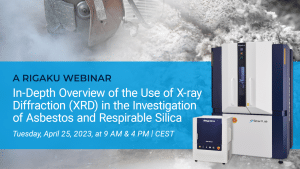Join us for a webinar on April 25, 2023 for an In-Depth Overview of the Use of X-ray Diffraction (XRD) in the Investigation of Asbestos and Respirable Silica.
Crystalline silica is one of the most common minerals in the earth’s crust and can occur in various polymorphic phases. Although these materials appear harmless, they can become hazardous when exposed to external actions such as grinding, sawing, cutting, etc. Respirable crystalline silica (RCS) is converted into extremely small particles of a few micrometres that can cause respiratory diseases. Health and safety regulations for workers dealing with silica and asbestos are very strict. For example, respirators must be routinely analyzed to determine the amount of material present.
In this context, X-ray diffraction (XRD) is one of the most important techniques for detecting and quantifying even small amounts of these hazardous substances.
The Rigaku benchtop or floor-standing X-ray diffractometers, controlled by SmartLab Studio II (SLSII) software, offer state-of-the-art solutions for ultra-low limit of detection (LOD) and limit of quantification (LOQ) analysis. With a special plug-in in SLSII, the user can determine LOD/LOQ values within a few minutes, e.g. for respiratory filters. In particular, our compact benchtop X-ray diffractometer series MiniFlex600 (MF600) with high X-ray power (600 W), automatic 8-position sample changer and state-of-the-art silicon strip detector offers a cost-effective, fast and highly sensitive solution.


